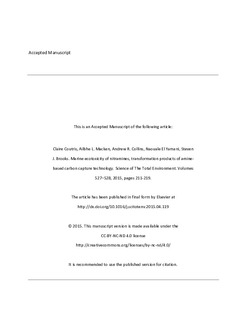| dc.contributor.author | Coutris, Claire | |
| dc.contributor.author | Macken, Ailbhe | |
| dc.contributor.author | Collins, Andrew Richard | |
| dc.contributor.author | El Yamani, Naouale | |
| dc.contributor.author | Brooks, Steven | |
| dc.date.accessioned | 2018-11-08T08:55:16Z | |
| dc.date.available | 2018-11-08T08:55:16Z | |
| dc.date.created | 2015-05-19T09:10:02Z | |
| dc.date.issued | 2015-05-14 | |
| dc.identifier.citation | Science of the Total Environment. 2015, 527-528 211-219. | nb_NO |
| dc.identifier.issn | 0048-9697 | |
| dc.identifier.uri | http://hdl.handle.net/11250/2571531 | |
| dc.description.abstract | In the context of reducing CO2 emissions to the atmosphere, chemical absorption with amines is emerging as the most advanced technology for post-combustion CO2 capture from exhaust gases of fossil fuel power plants. Despite amine solvent recycling during the capture process, degradation products are formed and released into the environment, among them aliphatic nitramines, for which the environmental impact is unknown. In this study, we determined the acute and chronic toxicity of two nitramines identified as important transformation products of amine-based carbon capture, dimethylnitramine and ethanolnitramine, using a multi-trophic suite of bioassays. The results were then used to produce the first environmental risk assessment for the marine ecosystem. In addition, the in vivo genotoxicity of nitramines was studied by adapting the comet assay to cells from experimentally exposed fish. Overall, based on the whole organism bioassays, the toxicity of both nitramines was considered to be low. The most sensitive response to both compounds was found in oysters, and dimethylnitramine was consistently more toxic than ethanolnitramine in all bioassays. The Predicted No Effect Concentrations for dimethylnitramine and ethanolnitramine were 0.08 and 0.18 mg/L, respectively. The genotoxicity assessment revealed contrasting results to the whole organism bioassays, with ethanolnitramine found to be more genotoxic than dimethylnitramine by three orders of magnitude. At the lowest ethanolnitramine concentration (1 mg/L), 84% DNA damage was observed, whereas 100 mg/L dimethylnitramine was required to cause 37% DNA damage. The mechanisms of genotoxicity were also shown to differ between the two compounds, with oxidation of the DNA bases responsible for over 90% of the genotoxicity of dimethylnitramine, whereas DNA strand breaks and alkali-labile sites were responsible for over 90% of the genotoxicity of ethanolnitramine. Fish exposed to > 3 mg/L ethanolnitramine had virtually no DNA left in their red blood cells. | nb_NO |
| dc.description.abstract | Marine ecotoxicity of nitramines, transformation products of amine-based carbon capture technology | nb_NO |
| dc.language.iso | eng | nb_NO |
| dc.subject | Environmental risk assessment | nb_NO |
| dc.subject | Post-combustion CO2 capture | nb_NO |
| dc.subject | 2-(Nitroamino)ethanol | nb_NO |
| dc.subject | Single cell gel electrophoresis | nb_NO |
| dc.title | Marine ecotoxicity of nitramines, transformation products of amine-based carbon capture technology | nb_NO |
| dc.title.alternative | Marine ecotoxicity of nitramines, transformation products of amine-based carbon capture technology | nb_NO |
| dc.type | Journal article | nb_NO |
| dc.type | Peer reviewed | nb_NO |
| dc.description.version | acceptedVersion | nb_NO |
| dc.source.pagenumber | 211-219 | nb_NO |
| dc.source.volume | 527-528 | nb_NO |
| dc.source.journal | Science of the Total Environment | nb_NO |
| dc.identifier.doi | 10.1016/j.scitotenv.2015.04.119 | |
| dc.identifier.cristin | 1243212 | |
| dc.relation.project | Norges forskningsråd: 199874 | nb_NO |
| cristin.ispublished | true | |
| cristin.fulltext | postprint | |
| cristin.qualitycode | 2 | |
